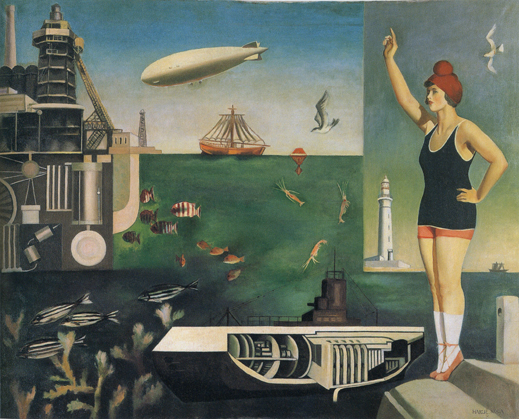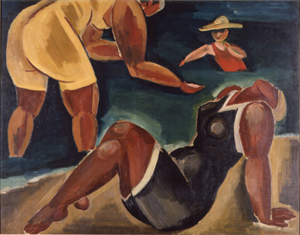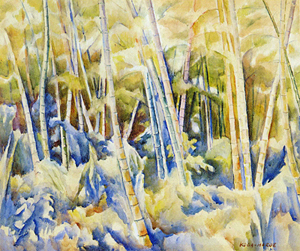 |
Focus features two in-depth reviews each month of fine art, architecture and design exhibitions and events at art museums, galleries and alternative spaces around Japan. The contributors are non-Japanese art critics living in Japan. |
|
|
 |
 |
 |
Koga Harue: A Retrospective -- Journeying back to a time when the "self" was uncharted territory
Edan Corkill |
 |
 |
Sea (1929). Oil on canvas. The National Museum of Modern Art, Tokyo. Photo by Norihiro Ueno
|
Given the chance to go back in time to any decade in the 20th century in Japan, who wouldn't choose the 1920s?
The giddiness of Japan's military victory over Russia in 1905 had translated into robust industrial development which in turn had led to explosions in urbanization and hence increased leisure time. The Japanese film industry really took off at this time, modern sports such as tennis became popular and retailers like Shiseido livened up the streets of Ginza with brand new ice cream parlors. In the creative arts, and in visual arts in particular, the appetite of young Japanese for tastes from abroad was no less voracious.
A new exhibition at the Museum of Modern Art, Hayama presents one of the most comprehensive retrospectives of an artist who was at the very center of this creative ferment. A sample of the work produced by Harue Koga between 1920 and 1933, when he died at age 38, includes hints of every contemporary Western art movement from Futurism and Cubism to Surrealism.
 |
Bathing (1922). Oil on canvas. The Museum of Modern Art, Wakayama.
|
A statement made by Koga about painting in 1926 pinpoints the source of the energy that sustained him: gIn my mind, the path art should take does not lie in standards stipulated by external conditions but in the internal expression itself. I believe that the right path is no other than a pure and free expression of oneself, which is not restricted by anything.h
In other words, Koga (and his entire generation) were awakening to Modernism. The task of painting was no longer to represent external landscapes, but internal ones -- not society as it is, but as an individual thought it was or should be.
The current exhibition illustrates this shift nicely by starting with Koga's early realist watercolors and oil paintings from the 1910s -- people and scenes from his hometown of Kurume, Fukuoka Prefecture. The simplicity of those works barely hints at the complexities unleashed in the following decade. Human figures first become stylized assemblages of geometrical shapes, and then shattered approximations in Cubist works.
 |
Bamboo Grove (Bamboo Thicket) (1920).
Watercolor on paper. Fukuoka Prefectural Museum of Art.
|
Koga is best known for his Surrealism-inspired works from around 1930. Sea, from 1929, is an imaginary celebration of all the possibilities held out by a rapidly progressing society. A submarine, a factory and a blimp represent industrialization; detailed depictions of fish and shrimp suggest scientific discovery; and a female bather represents leisure and sexuality.
Included in the exhibition are not just this and around 60 other large-scale oil paintings, but the original circus postcards and science magazine clips that Koga freely sampled in making them. Gazing at this treasure trove, it's easy to get a sense of the excitement that Koga felt himself.
With so many paintings on show, the exhibition offers several new discoveries, too. One painting called Interior, in particular, stood out. Ostensibly depicting just a series of doors, the work also comes across as a kind of symbolic self-portrait. A Western-style door is swung open into a corridor revealing both an open Japanese-style sliding door on the far side and a darkened alcove beyond that. In this elegantly geometric composition, with its pattern of repeated rectangular doorframes and oblongs of colors, Koga seems to be portraying himself -- as a Japanese room in a brand-new Western house.
 |
Existence (1933). Watercolor on paper. Kawabata Foundation.
This work was on display until October 17 only.
|
|
 |
 |
Edan Corkill
Edan Corkill is a staff writer in the arts, entertainment and features section of The Japan Times. He also edits the Japanese Art Scene Monitor, a bi-monthly email magazine published by the Australian Embassy. |
|
 |
|